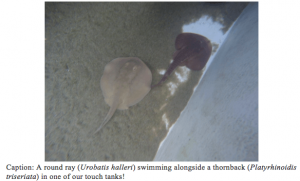
Snorkeling above the sandy bottoms of CIMI’s shores, you might spot a cute little ray shuffling along… or is it a skate? No wait, it is a ray! But it might be a skate. Maybe. These closely related cartilaginous fish can certainly be difficult to tell apart, but each has certain qualities that make it unique and distinguishable.

Though both rays and skates have flattened bodies with which they can hide on the ocean floor, skates typically have fleshier tails with enlarged, thorny scales running along their backs for protection. Meanwhile, most rays have thinner tails barbed with one or two stinging spines that ward off potential predators. If you happen to see these guys moving about, you might observe that they swim differently too. Skates move by undulating their tails left and right, whereas rays flutter and flap their pectoral fins to get where they need to go.
Beyond the differences that you might notice at a glance, rays and skates have unique life cycles with disparate modes of reproduction. Skates are oviparous, which means that they reproduce by laying eggs. These eggs (or “mermaid purses” as they’re often called) are dark and flat with small projections that keep them anchored to marine substrate. Each egg is equipped with nutrients to keep the developing skates healthy for up to 12 weeks, at which point the pup will hatch and take on the big bad ocean. Rays, on the other hand, are viviparous, meaning that they give live birth to their pups. The gestational period (a.k.a. pregnancy) of some ray species can last over a year and once born, the juvenile rays usually separate from their mothers.
Ever wondered what these are?
The next time you find yourself face to face (or fin to fin) with a flat cartilaginous fish, remember these differences so that you can distinguish the tail-stinging, fin-flapping, birth-giving rays from those back-spiking, tail-swinging, egg-laying skates.
Source:
http://www.elasmo-research.org/education/shark_profiles/skate_or_ray.htm


